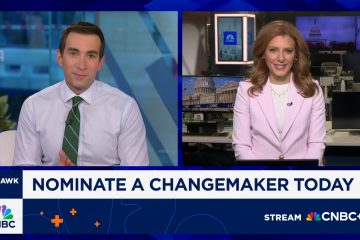
Getty Images
About 1 in 5 Americans say they regularly get their news from “news influencers” on social media, according to a new study by the Pew Research Center.
The rise of social media personalities doling out information was particularly true among the youngest users, and comes at a time of heightened polarization surrounding the U.S. presidential election.
“We thought about news influencers as sources of authority to their audiences about what’s happening in the world,” Galen Stocking, a senior computational social scientist at the Pew Research Center, told CNBC. “And one thing we found when doing that, 65% said that they found the information they got from news influencers helps them better understand the world.”
Close to 40% of adults under 30 who were included in the study said they stay informed from independent social media figures, the largest chunk of any age group.
Democratic strategist and Columbia professor Basil Smikle said that shift has been playing out since at least 2016.
“Part of it is convenience,” Smikle said. “You have access to all the information you need from your phone. So because social media is pushing information to you, the ease with which you have information at your fingertips is difficult to ignore.”
But Smikle said that convenience can turn into a habit that’s hard to break and may lead to a greater spread of misinformation.
“When you’re getting information through social media, how do you know how original that information is?” he said. “It’s very hard to verify that and unfortunately, the algorithm doesn’t care. It just keeps sending you the same kind of information.”
Around two-thirds of the roughly 500 accounts that Pew defined as “news influencers” for the study were active on multiple platforms between July and August.
Social media site X remained the most popular, with 85% of influencer respondents reporting they were on the site. Meta-owned Instagram took second place, while YouTube, the most popular platform for Gen Z, or people born between 1997 and 2012, came in third. TikTok sat below Meta’s Threads and Facebook as sixth-most popular among influencers.
Risk of misinformation
Questions around the influence of independent social media creators on politics erupted prior to and after the presidential election.
Both candidates utilized social media to reach younger voters, most notably when President-elect Donald Trump appeared on Joe Rogan’s podcast and Vice President Kamala Harris joined the “Call Her Daddy” podcast — both podcasts with large followings on social media.
Vice President Kamala Harris sits for an interview with Alex Cooper on the “Call Her Daddy” podcast.
Call Her Daddy
“The ease with which you can get in front of a voter with information has increased exponentially, and I can consistently send you that information so much so that there comes a point where you’re not going to go look for it,” Smikle said.
Smikle said social media is also a much less expensive option for candidates trying to reach a larger audience, especially when you add in news influencers who can post about the candidates and their platforms.
Candidates may also have an easier time advancing their message via podcasts rather than a traditional interview on a network, according to Syracuse professor Joshua Darr. Network interviews in recent elections have tended to be more combative than those conducted on independent podcasts or social media accounts, Darr said.
“It’s probably good for the electorate to have a hard sit-down interview, but if it’s a series of rapid fire gotcha questions, I don’t know if that’s something campaigns are going to sign up for,” he said.
One result, according to Smikle, is that misinformation can spread more easily.
“There were standards that the networks used to determine what was true,” he said. “Those guardrails are gone through social media.”
Alaina Wood, one of the news influencers listed in the Pew report, said misinformation often becomes too widespread to combat until after it’s already had real impact.
Wood’s content is primarily based on climate news, particularly with her series that highlights positive climate stories. After her east Tennessee community was hit by Hurricane Helene in September, she said misinformation began to spread about people accused of stealing in the wake of the storm.
“Everyone kind of agrees that trying to get a handle on misinformation before it becomes a thing can really help,” she said. The problem, according to Wood, is that videos correcting misinformation often don’t go as viral as the original clip.
More male, conservative
Previous Pew research found more women consume news on sites including Facebook, Instagram and TikTok than men, but the new survey suggests close to two-thirds of news influencers are men.
That difference is seen most with YouTube and Facebook, where 68% and 67% of news influencers are men, respectively. On TikTok, around 50% of respondents were men, compared with 48% women and 2% who identify either as nonbinary or whose gender could not be determined.
Joe Rogan on his podcast (L) and Former US President and Republican presidential candidate Donald Trump speaks during a roundtable discussion with Latino community leaders at Trump National Doral Miami resort in Miami, Florida on October 22, 2024 (R).
Getty Images
Matteo, who goes by “The Justice Guy” across his social media accounts, is another influencer listed in the report who often clashes online with other creators around misinformation and national politics. He said he’s noticed major differences in the gender breakdown of his audiences across different platforms as well as their political ideologies.
“On YouTube I get roasted,” he told CNBC. “That’s not going to stop me from posting what I post. But I would say the vast majority of the people that responds to my videos are very conservative. And I would say that probably YouTube is as close to MAGA as as you can get.”
Among the 52% of influencers who responded to Pew researchers with an explicit political orientation, more identified with right-leaning politics, according to the report. That difference is amplified on certain platforms, including Facebook, where three times as many respondents identified as conservative than those who identified as liberal.
Matteo said his audience on TikTok, where he started his social media following and which remains his primary platform today, is much more liberal and primarily women.
“Most people will interact with the content that they enjoy, and that feeds the algorithm and creates echo chambers,” he said. “If you’re not aware of it, you end up thinking 100% of the people around you feel a certain way, just because you feel this affinity with the information you’re consuming.”
Creating silos
Political stratification on social media may only increase as time goes on.
X owner Elon Musk has become a close ally of Trump’s, drawing criticism from many on social media and spurring some to leave the platform altogether.
Jay Rosen, a journalism professor at New York University and one of the influencers listed in the Pew report, announced he would leave X the Monday after the election.
“For a while Twitter was a way to do journalism education in public, for a public— and for free,” he wrote on X. “I think I was effective at times in that role. I no longer know how that’s done.”
Micro-blogging startup Bluesky, which has set itself up as an alternative to X, gained more than 1.25 million new users in the week following Trump’s victory.
“I’m fully aware of the fact that people’s decision to not post on X is amplifying that echo chamber,” Matteo said. “So it’s creating an even more radicalized audience, because that is all they’re hearing from.”





